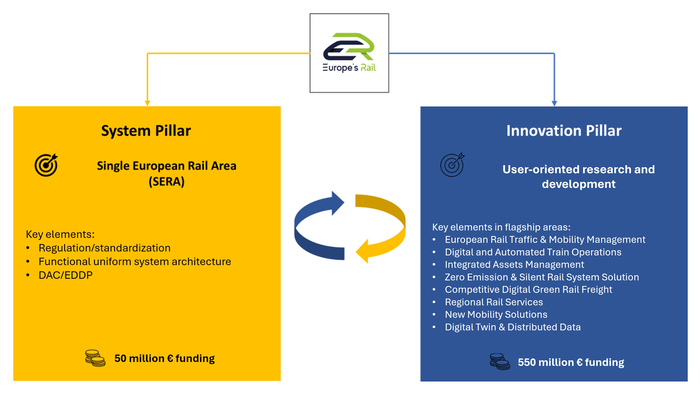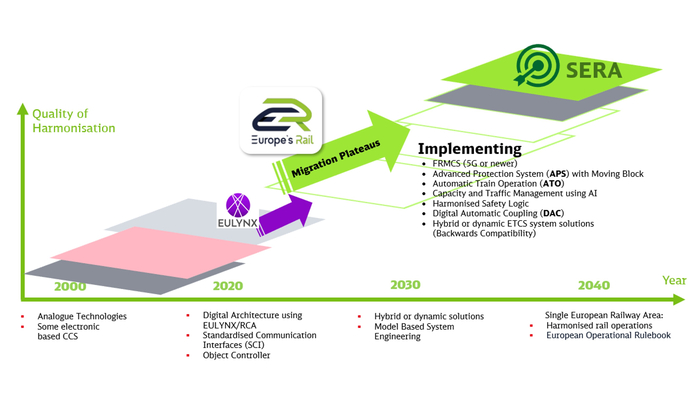
Europe's Rail System of the Future
Digitale Schiene Deutschland contributes technologies for a digital rail system to the EU Rail Innovation Program
Digitale Schiene Deutschland (DSD) is a member of Europe's Rail Joint Undertaking (EU-Rail), a technology initiative launched by the European Council in 2021 as part of the EU innovation program “Horizon Europe”. In line with the European Commission's European Green Deal, rail and network operators, industrial companies, and research institutions are working together on the digitalization and automation of the rail transport sector in Europe.
The vision of EU-Rail is a “Single European Railway Area” with a high-performance, interoperable European rail network. To achieve this goal, the potential of digitalization and automation technologies will be leveraged to increase the capacity of rail transport, enhance flexibility and reliability, and reduce costs. The project is based on a robust functional system architecture shared by the industry, which is being developed in coordination with the European Railway Agency (ERA). Onboard are the future technologies of Digitale Schiene Deutschland, such as the future train radio “FRMCS”, the Advanced Protection System (APS) - as the next generation of train protection technologies - as well as highly and fully automated driving (Automatic Train Operations, ATO).
EU-Rail is based on two pillars: the System Pillar and the Innovation Pillar (see Figure 2). The task of the System Pillar is to support the further development of the rail system through a coherent and coordinated approach. This is based on a system architecture approach that enables Europe-wide interoperable and modular technical equipment of vehicles and routes with digital control and safety technology (ATO, train radio FRMCS, etc.). The System Pillar has a funding volume of approximately 50 million euros.

The Innovation Pillar comprises research and development projects and has the task of developing operational and technological solutions. The activities carried out are aimed at large-scale demonstrations and include technologies of all maturity levels as well as exploratory research. The 30 participating partners have a total funding volume of 550 million euros at their disposal (see figure), with Deutsche Bahn, as a founding member, being promised a project volume of 55.4 million euros (2022 to 2030). Deutsche Bahn contributes mainly personnel services to the project work. The development projects are being implemented in seven thematic areas, known as flagship areas. Digitale Schiene Deutschland (DSD) is mainly involved in Flagship Area 2.
R2DATO - Digital & Automated Train Operations
The Digital & Automated Train Operations (R2DATO) R&D project is being led by SNCF and Hitachi. DB is also involved in Flagship Area 1 “Motional” and Flagship Area 3 “iam4Rail”. In this project, six of 48 work packages are managed and implemented by Digitale Schiene Deutschland (DSD). Until the end of the project duration of R2DATO Phase 1 of FA 1 in 2026, the focus is on the overall development towards automated train operation (ATO). The aim is to achieve concrete results on key ATO topics. A central component of the project is also the development of the next generation of train control technologies and the introduction of scalable, automated, and even autonomous train operating models. This includes the implementation of a Future Railway Mobile Communication System (FRMCS), a digital register, a standardized information and communication technology platform (ICT platform) for vehicles and the development of an ETCS level 3 moving block demonstrator based on APS. These technologies play an important role in the development of ATO and are therefore also considered.
The focus here is on testing moving block operations up to technology readiness level 6 (TRL 6), i.e., the creation of a prototype. The main objective is to demonstrate the feasibility of a new architecture that already uses standardized interfaces such as ETCS and EULYNX from System Pillars. This architecture replaces the conventional block-based control logic with a train-oriented safety logic. Other focal points include the validation of a generic safety logic concept and compatibility with the ETCS system. A hybrid localization approach combines trackside sensors and on-board technologies for precise monitoring of track occupancy. In addition, the further development of the results from previous projects up to a standardized interface between the vehicle management system (TCMS, Train Control Management System) and ATO/ETCS as well as the work on a modular onboard platform for vehicles will be focused on.
With these contributions to EU Rail, Digitale Schiene Deutschland is playing a leading role in the design of future on-board platform technologies and future trackside safety systems. The establishment of a European network between industry and rail companies creates interfaces for the detailed coordination of necessary subsystems and technological solutions.
For the DSD product portfolio in particular, this opens up the possibility of standardizing components and interfaces across Europe from the outset. In addition, the further development of central topics such as localization, train integrity, moving block, and digital register has a strategic benefit for DB InfraGO AG. These research and development projects as part of R2DATO are crucial building blocks for achieving the goals of DSD.
Outlook and Conclusion
R2DATO is currently being implemented. Important DSD demonstrators are being built and tested in 2025. The resulting findings provide insights into the technical feasibility and lay the groundwork for further developments towards harmonization and implementation. At the same time, the project team is already planning and shaping the next project wave of EU-Rail, which includes the follow-up project to R2DATO for 2026 to 2029. Together with the DB Group, DB-Cargo, and other stakeholders, forward-looking technologies are being analyzed and brought into the consortium. The direction is clear: every project, every specification, and every demonstration brings the vision of a highly developed, high-performance, and harmonized European railway system closer.
The Main Components of the Project at a Glance
- Train-Oriented System for Safe Routing and Moving Block Operations
A significant demonstrator project in R2DATO for DSD is the Moving Block Demonstrator. This project tests a train-oriented safety logic based on the concepts of Advanced Digital Infrastructure (ADI), which, among other things, enables driving in the “moving block”. - Prototype for Highly Automated Train Systems
The Onboard Platform Demonstrator implements a reference model of an on-board computing platform. It integrates example applications with low to very high functional safety requirements. Alongside the modular computing platform, this work package also demonstrates concepts for standardized platform diagnostics and the integration of the platform with FRMCS communication functions to the track. - Digitales Register: Ein Schlüssel zur Zukunft des automatisierten Bahnverkehrs
Die vom Digitalen Register bereitgestellten Infrastrukturdaten sollen im zukünftigen automatisierten Bahnbetrieb in den Stufen GoA2 bis GoA4 allen Eisenbahnverkehrsunternehmen (EVU) gleichermaßen zur Verfügung gestellt werden. Aus diesem Grund ist es notwendig, das zugrunde liegende Datenmodell und die Schnittstellen der Systeme europaweit zu standardisieren. -
Modular and Secure Computer Platforms
This work package realizes a reference implementation of a modular and secure computer platform, specifying the vehicle-side onboard components (e.g., ETCS Onboard Unit, ATO Onboard Unit) and infrastructure-side applications (Data Center, TSO). Functionally safe applications are integrated in a laboratory environment and connected via FRMCS. The resulting platform will host both safety-relevant and non-safety-relevant functions.

Funded by the European Union. Views and opinion expressed are however those of Digitale Schiene Deutschland only and do not necessarily reflect those of the European Union. Neither the European Union nor the granting authority can be held responsible for them.
